Love them or hate them, no tropical garden is complete without those wild and crazy vines. They latch on where they don't belong, require persistent pruning, take up more space than they're ever given and will swallow up a shed within a week if given the chance, but we grow them for one very good reason — the flowers, of course. Here are some of the showiest blooming vines you'll see from late summer through fall.
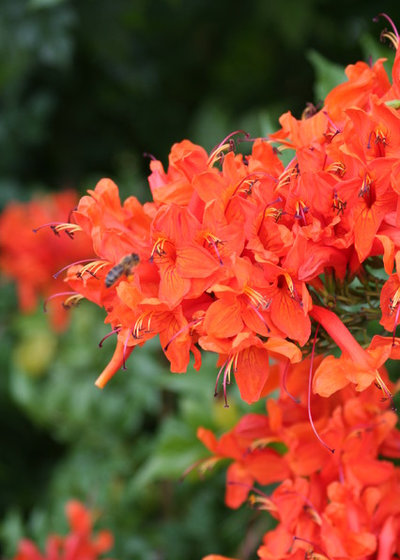 Cape Honeysuckle
Cape Honeysuckle(
Tecoma capensis)
You'll love this sprawling and rambling vine (more of a shrub, really) for its profusion of vibrant orange flowers and its fine evergreen foliage. As you can tell by the bee in the photo, pollinators love it too — hummingbirds especially. The flowers that cover the plant in summer and fall range from a golden orange to a deep and dramatic red-orange, so purchase a plant when it's in bloom so that you get the type that suits your landscape.
Cape honeysuckle makes a large and untidy mass of prolifically blooming stems, but it can be trained to grow up trellises if you help it along by tying the rambling stems loosely to their support. Use it as a ground cover on large hillsides or to control erosion, but be prepared to give it lots of room. It will spread.
Gardeners in colder climates are also in luck. As long as you're willing to give it an occasional trim, cape honeysuckle works well in the container garden and can be held upright with the help of stakes or allowed to scramble over the pot's edge.
Where it will grow: Hardy to 20 degrees Fahrenheit (USDA zones 9 to 11; find your zone)
Water requirement: Low once established
Light requirement: Full sun
Mature size: 6 to 8 feet
Seasonal interest: The biggest flush of blooms is from late summer into fall.
When to plant: Spring through fall
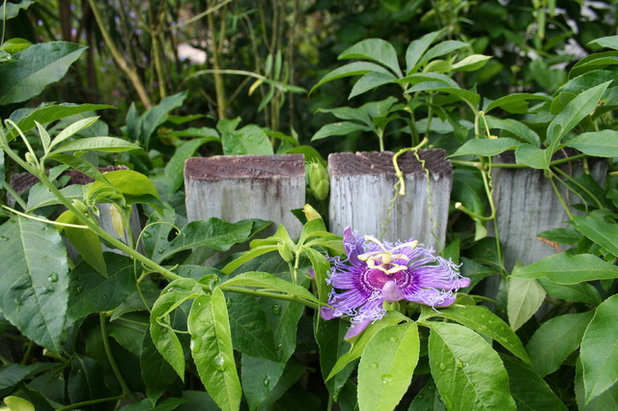 Passionflower
Passionflower(
Passiflora spp)
They come in all sorts of colors, ranging from the intense scarlet blooms of red passionflower (
Passiflora miniata) to the pastel lemon passionflower (
Passiflora citrinus) and white passionflower (
Passiflora 'Constance Elliott'). Not that passionflowers really need much else to warrant their use, but edible types — like the passion fruit (
Passiflora edulis) and giant granadilla (
Passiflora quadrangularis) — are delicious eaten out of hand, added to ice cream or juiced.
Passionflowers are valuable host plants for butterflies, especially those that are native to your area. Maypop is native to much of the eastern United States and has the bonus of producing edible fruits, and corky stem passionflower (
Passiflora suberosa) is a good choice for most of Florida. Another one to look for is incense passionflower (
Passiflora 'Incense'), which comes loaded with a surprisingly strong fragrance.
They don't need much in the way of care, but passionflowers are usually very vigorous (some would use the word "weedy") and may need to be heavily pruned or pulled up from time to time. That is, if the butterfly caterpillars don't get to them first.
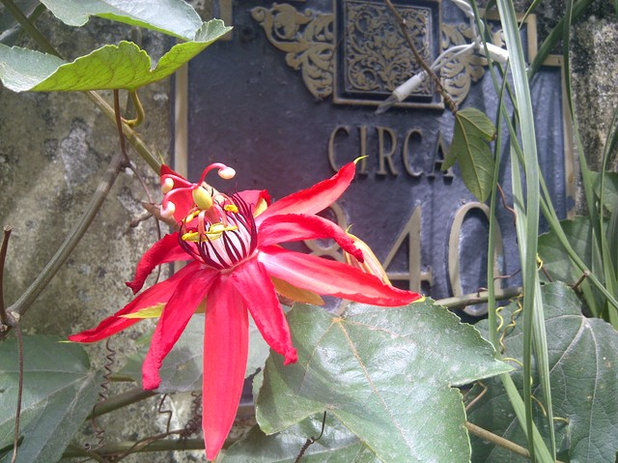
Red passionflower (
Passiflora miniata) is one of the more dramatic species available and will occasionally bear edible fruit.
Where it will grow: Varies by species. Some are hardy to -10 degrees Fahrenheit (zones 6 to 11).
Water requirement: Average
Light requirement: Partial to full sun
Mature size: Varies, but most reach 6 to 8 feet
Seasonal interest: Summer through fall
When to plant: Spring through fall
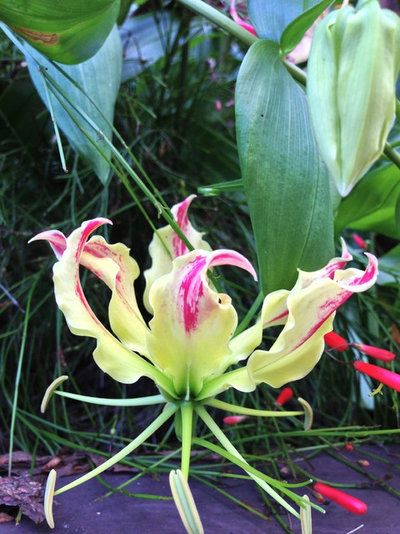 Gloriosa LilyGloriosa superba
Gloriosa LilyGloriosa superba 'Rothschildsiana'
This vining lily lookalike has flowers that are every bit as exotic looking as those of the passionflower, but with a twist. First of all the flowers have twisted petals, and the blooms face downward, looking much like comets or flickering flames as they change from a pale yellow to full-blown orange and red.
Plant the long and fleshy roots just as you would bulbs, 2 to 3 inches below the soil surface from spring through summer. Tropical gardeners and impatient gardeners in colder climates can add container-grown plants to the garden whenever freezes aren't an issue.
Plant gloriosa lilies near a support such as a wire trellis or an informal shrub, so that the unique tendril-like leaf tips can grab a foothold. Resist the urge to prune errant stems, as doing so will kill back the entire stem to the ground and delay blooming.
Where it will grow: Hardy to 20 degrees Fahrenheit (zones 9 to 11)
Water requirement: Average
Light requirement: Partial to full sun
Mature size: Rambling vine 4 to 6 feet long
Seasonal interest: Summer through fall
When to plant: Spring though summer
Caution: All parts of gloriosa lily are poisonous if ingested, and handling the roots can be irritating to some, so plant it out of the reach of children and handle the roots using gloves as a precaution.
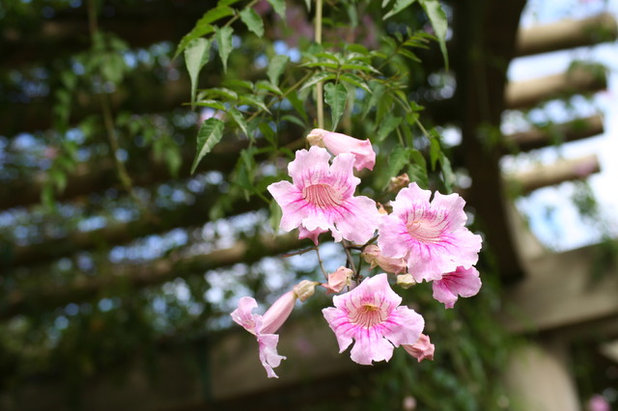 Pink Trumpet Vine
Pink Trumpet Vine(
Podranea ricasoliana)
Its cotton-candy-pink and trumpet-shaped blooms resemble those of the related crossvine and trumpet creeper (which are also good choices as well), but this South African native speaks in softer tones and ha finer foliage, making it ideal where a touch of subtlety is needed. Oh, and did I mention that it smells amazing?
Plant this one at the base of your tallest trellis, fence or pergola, as it has the potential to grow 20 feet tall when given the space. It's also drought tolerant once established and requires little care if it's given enough room to roam freely. It might be suitable for containers, provided you have pruning shears at the ready to keep it in scale.
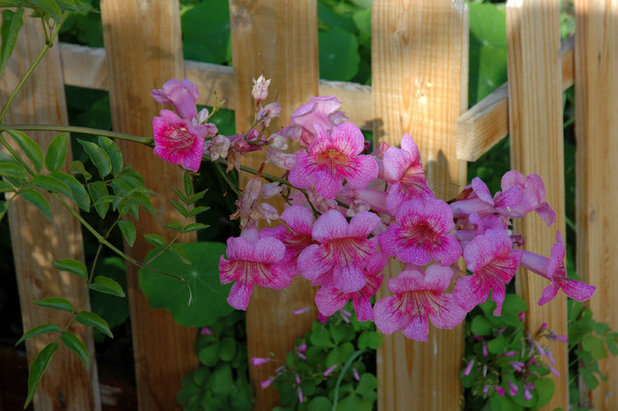
Noelle Johnson Landscape Consulting
This pink trumpet vine is twining along a fence.
Where it will grow: Hardy to 20 degrees Fahrenheit (zones 9 to 11)
Water requirement: Low
Light requirement: Full sun; will take some shade
Mature size: 15 to 20 feet
Seasonal interest: Flowers summer through fall
When to plant: Spring through fall where hardy
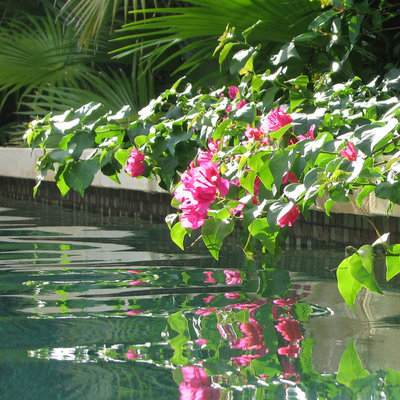 Bougainvillea
Bougainvillea(
Bougainvillea glabra)
Out of all of the vines in this ideabook, bougainvillea is the most common; it can be found in gardens anywhere from the coast of Florida to California, where it scales entire trees and stucco mansions. It naturally lends itself to Mediterranean architecture, with its muscular and winding woody trunks and rosy warm-hued blooms, or maybe it's just because of its exceptional drought tolerance?
What most people consider the flowers are actually papery and colorful adapted leaf-like structures called bracts that surround the real flowers, which are usually insignificant and white. The second most noticeable feature is a bit more unpleasant, as the entire plant is usually armed with narrow and piercing thorns — sure to make any burglar's evening an unforgettable experience if it's planted along a wall.
Bougainvillea can be pruned back hard in spring, or you can remove the lower branches to reveal the twisting and fissured trunk as a piece of living sculpture. Just be sure to look but not touch.
Where it will grow: Hardy to 20 degrees Fahrenheit (zones 9 to 11)
Water requirement: Low
Light requirement: Full sun
Mature size: Up to 40 feet
Seasonal interest: Summer through fall
When to plant: Spring through fall





